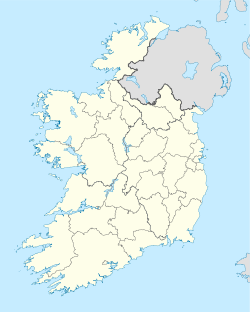- Doolough
-
Doolough — Town — Location in Ireland Coordinates: 54°08′37″N 9°55′46″W / 54.14361°N 9.929444°WCoordinates: 54°08′37″N 9°55′46″W / 54.14361°N 9.929444°W Country Ireland Province Connacht County County Mayo Elevation 00 m (0 ft) Time zone WET (UTC+0) – Summer (DST) IST (WEST) (UTC-1) Irish Grid Reference F Doolough is a coastal townland covering an area of 2,493 acres (10.09 km2) in Kiltane Parish, Erris, North County Mayo. It is on the Doohoma peninsula south of Belmullet town. Its name comes from its location on miles of local sand dunes and beaches.
Contents
History
This townland has been well populated throughout the years for its relatively remote location. In 1841 just before the Great Famine there were almost 600 people recorded as living here. By 1911 that population had almost halved to just 311 inhabitants.
With the arrival of Anglo-Norman families into Erris, families of Barretts, Burkes and Lynotts settled in the Doolough area. Sir Edmund Barrett, known as the Baron of Irrus, is recorded as residing in a castle at Doolough in 1585. He was knighted by Queen Elizabeth 1 for his favours to the Crown. His sons, Edmund and Richard were brought up in the household of Lord Essex in England. For the family's loyalty to the Crown, King James I in 1605 granted Sir Edmund more land in Erris and also a licence to hold a weekly fair at Doolough.[1]. This suggests that there was an affluence in the area at this time. The castle referred to was likely to have been located in the area known as Caislean or Caiseal. Part of the castle was still in use until 1937.[2] and the cobbles and stones from the castle were removed for the making of roads and houses in the area. Strangely it seems that the Barrett family had a major row with the crown in the early 17th century and went into armed revolt against it. They were shot and hanged like dogs and their property was confiscated. ([2])
By 1619 the castle was in the hands of Michael Cormuck who owned the Castle at Inver td in Kilcommon, Erris. After the Cromwell [3] period in the mid seventeenth century, the property passed into the hands of the new landlords of Erris - the Shaens, Carters and Binghams.
The first road connecting Erris with Ballina and Castlebar was completed in 1824. During the Irish famine the first substantial road to Doolough, Bothar na Sop, was constructed as a famine relief road. This allowed the people from Doolough to access the newly burgeoning Belmullet, situated approximately seven miles away. A road was also constructed to the Doolough Coastguard Station.
During the famine there were many evictions in the area and the Bingham landlords living in Doolough were reputed to be cruel landlords (CSOPR reports No. 31404 Mayo 1882). At the end of the nineteenth century when the Land League was most active, the people of the Doolough area were reputed to have been particularly vehement activists due to their poor treatment during the famine.
Doolough had a Coastguard Station, visible on the 1838 O.S. map, which was operational until the late 1880’s.[4] In 1853 a fishing officer attached to the Doolough Coastguard Station sent the following report to the Government regarding the fishing conditions in the area:
- 1852 - 189 second class boats fished, 520 fishermen, no boys.
- 1853 - 185 boats fished 677 fishermen and 51 boys.
Observation: Fishing much improved. No new curing establishment has been formed. There is one in existence. The fishing would be more productive if the men had better boats and gear.[3]
In 1899 the landlords were approached by the Congested Districts Board to sell their estates. Arthur Shaen Bingham was willing to sell some parts of his property provided that he was paid such a price for the sale as he regarded was sufficient. Eventually, a deal was struck and the Congested Districts Board and the Land Commission stripped and divided the land among the tenants.
A consequence of events in the 19th century was to be discovered in the 20th, when a number of skeletons were exposed by the prevailing winds on the extensive sand banks in Doolough. This was a children’s burial ground dating from the time of the Famine and the following years. In the early 1950’s, the remains were collected in large boxes, and subsequently buried in Glencastle Cemetery.
Many vessel have been lost along the coastline in Doolough. The Thompson and the Mitchell, both merchant ships were shipwrecked on this coast and the Lee, a coastguard boat was also lost. In the 1940s the Thelma, with a load of coal drifted onto Doolough Point where she was wrecked. Coal can still be found among the rocks along here.[5]
Doolough Races
The world famous Geesala Festival is a week long community based festival with a large range of events organised from the famous horse racing and dog racing events on the strand at Doolough,[4] showjumping, deep sea fishing, sports events, walks, dog show, contests, music for young and old etc...[6]
The Strand’s other main claim to fame is its distinction as the setting of the sports in J.M. Synge’s well known play ‘The Playboy of the Western World’.
References
- ^ Knox,H, History of Co. Mayo, (1908) Dublin
- ^ Western People October 16th 1954
- ^ Board of Works, Report 21 (1853)
- ^ [1]
See also
Kiltane County Mayo Horse Racing in Ireland Festivals
Categories:
Wikimedia Foundation. 2010.

